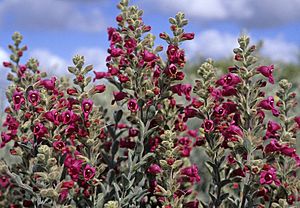Native foxglove facts for kids
Quick facts for kids Native foxglove |
|
|---|---|
 |
|
| A native foxglove plant growing near Mullewa in Western Australia. | |
| Scientific classification | |
| Genus: |
Dasymalla
|
| Species: |
terminalis
|
| Synonyms | |
|
|
Dasymalla terminalis, often called the native foxglove, is a beautiful flowering plant from the mint family called Lamiaceae. You can only find it in the south-west part of Western Australia. This plant is a shrub, which means it's a bushy plant, and it's covered in soft, white, woolly hairs on its branches, leaves, and even some parts of its flowers. Its leaves are thick and soft, and its flowers are shaped like tubes. They can be light to dark pinkish-purple or a deep red color.
Contents
What Does Native Foxglove Look Like?
Dasymalla terminalis is an upright shrub that usually grows to be about 0.5–1 m (2–3 ft) tall. Its branches and leaves are covered in thick, white or grey, woolly hairs.
Leaves of the Plant
The leaves are shaped like long ovals, measuring about 2–3.5 cm (0.8–1 in) long and 0.8–1.5 cm (0.3–0.6 in) wide. They are thick and soft to the touch. These leaves also have tiny bumps, but they are hidden by the plant's thick, woolly hair.
Flowers of the Native Foxglove
The flowers of the native foxglove are a lovely pale to deep pinkish-purple or a dark red color. They grow in groups of up to five, right where the leaves meet the stem. Each group sits on a hairy stalk that is about 3–5 mm (0.1–0.2 in) long. Some plants found near Lake Grace even have white flowers!
The flowers are surrounded by special leaf-like parts called bracts and bracteoles. These are hairy on the outside but smooth on the inside. The flower has five sepals, which are like small leaves that protect the bud. They are about 1–1.5 cm (0.4–0.6 in) long and join at their base to form a short tube. This tube is woolly on the outside and smooth inside.
The five petals of the flower are joined together to form a tube that is 15–20 mm (0.6–0.8 in) long and 8–10 mm (0.3–0.4 in) wide at the top. This tube has five lobes, or rounded sections, at its end. The outside of the tube has scattered hairs, but the inside is smooth, except for a ring of hairs near the ovary (where the seeds develop). The bottom petal lobe is almost round and nearly twice as big as the other four lobes, which are all about the same size.
The flower has four stamens (the parts that produce pollen) that are shorter than the petal tube. Two of these stamens are slightly shorter than the other two.
Flowering Season and Fruit
Native foxglove plants usually bloom from May to November or December. After the flowers, a hairy fruit develops. When this fruit is ready, it splits into two parts.
Plant Names: Taxonomy and Naming
The scientific name Dasymalla terminalis was first officially described in 1839 by a scientist named Stephan Endlicher. He published his description in a book called Novarum Stirpium Decades. The second part of the name, terminalis, comes from a Latin word meaning "of the ends."
Where Does Native Foxglove Grow?
This type of Dasymalla plant is the most widespread in its group. It grows across a large area of Western Australia. You can find it from near the Murchison River in the north-west all the way to Kalgoorlie in the south-east. It lives in several different natural areas, including the Avon Wheatbelt, Coolgardie, Esperance Plains, Geraldton Sandplains, Mallee, Murchison, and Yalgoo regions.
Protecting the Native Foxglove
The Western Australian Government's Department of Parks and Wildlife has classified Dasymalla terminalis as "not threatened." This means the plant is not currently at risk of disappearing.

